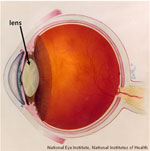Potential Implications for Cataract
Formation - Redox Changes at the Sulfur Atom of Methionine
summary written by Raven Hanna
In a similar way to your old pick-up truck rusting in the driveway, your body experiences a continuous battle against the elements. A constant barrage of oxidative stress attacks your cells and their constituent parts, including proteins. Like rust-proof paint on your vehicle, you have defense mechanisms that seek to prevent damage before it starts. But also like your trusty truck, once a weakness in the armor presents itself, it can spread rapidly — and often unnoticed — until you suddenly discover significant damage. Numerous diseases, as well as aging itself, are linked to uncontrolled oxidative processes that lead to irreversible damage and ultimately death. Understanding these oxidative processes may lead toward stopping and possibly even reversing damage.
Over the last decade, extensive studies of oxidative damage to proteins have shown that certain amino acids are more susceptible to oxidation than others. Methionine (MetS) is easily oxidized into its sulfoxide form (MetSO). This damaged form is readily reduced back to its natural form by enzymes, but sometimes it can build up and become further oxidized to sulfone (MetSO2), for which there is no easy way back to its original MetS form. MetS oxidation plays an important role in age-related cataracts. The most abundant protein in the eye lens, a-crystallin, aggregates and causes a marked decrease in the transparency of the lens - eventually leading to blindness. These protein aggregates show signs of oxidative damage, especially through oxidized forms of MetS. Long-term UV light exposure has been shown to increase oxidation of a-crystallin at methionine residues.
A research team led by Pierre Kennepohl of the University of British Columbia explored the basic photochemical processes of MetS that may lead to damage in lens proteins such as a-crystallin. This study, which relied heavily on x-ray absorption spectroscopy studies of the sulfur atoms (at the sulfur K-edge), performed at SSRL's BL6-2, showed that light-driven processes can lead to MetS oxidation but also to beneficial reductive processes that transform MetSO back to MetS. Which of these reaction directions is stronger is directly linked to the presence of dioxygen (O2). The crystalline lens is usually free of O2, ensuring that oxidative damage can be reversed when our eyes our exposed to light. However, lens levels of O2 are believed to increase with age, thus acquiring the conditions that allow age-related cataracts to form. These studies suggest that controlling the permeability of the crystalline lens towards dioxygen could prevent age-related cataracts. So the surface of the eye lens may, in fact, be quite similar to the rust-proof paint on your pickup. It may work well at first, but over time it can fail, allowing rust to set in. This work was published in the February 18 issue of the Journal of the American Chemical Society.
To learn more about this research see the full Scientific Highlight
A Karunakaran-Datt and P Kennepohl, "Redox Photochemistry of Methionine by Sulfur K-edge X-ray Absorption Spectroscopy: Potential Implications for Cataract Formation", J. Am. Chem. Soc., 131(10), 3577-3582 (2009).


